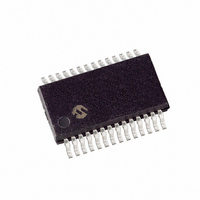PIC18F24J10-I/SS Microchip Technology, PIC18F24J10-I/SS Datasheet - Page 157

PIC18F24J10-I/SS
Manufacturer Part Number
PIC18F24J10-I/SS
Description
IC PIC MCU FLASH 8KX16 28SSOP
Manufacturer
Microchip Technology
Series
PIC® 18Fr
Datasheets
1.PIC16F616T-ISL.pdf
(8 pages)
2.PIC18F24J10-ISO.pdf
(368 pages)
3.PIC18F24J10-ISO.pdf
(6 pages)
4.PIC18F24J10-ISO.pdf
(6 pages)
5.PIC18F24J10-ISO.pdf
(12 pages)
6.PIC18F44J10-IPT.pdf
(358 pages)
Specifications of PIC18F24J10-I/SS
Program Memory Type
FLASH
Program Memory Size
16KB (8K x 16)
Package / Case
28-SSOP
Core Processor
PIC
Core Size
8-Bit
Speed
40MHz
Connectivity
I²C, SPI, UART/USART
Peripherals
Brown-out Detect/Reset, POR, PWM, WDT
Number Of I /o
21
Ram Size
1K x 8
Voltage - Supply (vcc/vdd)
2.7 V ~ 3.6 V
Data Converters
A/D 10x10b
Oscillator Type
Internal
Operating Temperature
-40°C ~ 85°C
Processor Series
PIC18F
Core
PIC
Data Bus Width
8 bit
Data Ram Size
1 KB
Interface Type
SPIC/I2C/EUSART
Maximum Clock Frequency
40 MHz
Number Of Programmable I/os
21
Number Of Timers
3
Maximum Operating Temperature
+ 85 C
Mounting Style
SMD/SMT
3rd Party Development Tools
52715-96, 52716-328, 52717-734, 52712-325, EWPIC18
Development Tools By Supplier
PG164130, DV164035, DV244005, DV164005, PG164120, DM183032, DV164136
Minimum Operating Temperature
- 40 C
On-chip Adc
10-ch x 10-bit
Lead Free Status / RoHS Status
Lead free / RoHS Compliant
For Use With
AC162074 - HEADER INTRFC MPLAB ICD2 44TQFPAC162067 - HEADER INTRFC MPLAB ICD2 40/28P
Eeprom Size
-
Lead Free Status / Rohs Status
Lead free / RoHS Compliant
Available stocks
Company
Part Number
Manufacturer
Quantity
Price
Company:
Part Number:
PIC18F24J10-I/SS
Manufacturer:
MICROCHIP
Quantity:
1 667
Part Number:
PIC18F24J10-I/SS
Manufacturer:
MICROCHIP/微芯
Quantity:
20 000
- PIC16F616T-ISL PDF datasheet
- PIC18F24J10-ISO PDF datasheet #2
- PIC18F24J10-ISO PDF datasheet #3
- PIC18F24J10-ISO PDF datasheet #4
- PIC18F24J10-ISO PDF datasheet #5
- PIC18F44J10-IPT PDF datasheet #6
- Current page: 157 of 358
- Download datasheet (6Mb)
15.4
The MSSP module in I
master and slave functions (including general call
support) and provides interrupts on Start and Stop bits
in hardware to determine a free bus (multi-master
function). The MSSP module implements the standard
mode specifications as well as 7-bit and 10-bit
addressing.
Two pins are used for data transfer:
• Serial clock (SCLx) – RC3/SCK1/SCL1 or
• Serial data (SDAx) – RC4/SDI1/SDA1 or
The user must configure these pins as inputs by setting
the TRISC<4:3> or TRISD<1:0> bits.
FIGURE 15-7:
© 2007 Microchip Technology Inc.
Note: Only port I/O names are used in this diagram for
RD0/PSP0/SCK2/SCL2
RD1/PSP1/SDI2/SDA2
RC3 or
RC4 or
RD0
RD1
the sake of brevity. Refer to the text for a full list
of multiplexed functions.
I
2
C Mode
Read
Shift
Clock
MSb
SSPxADD reg
Stop bit Detect
Match Detect
MSSP BLOCK DIAGRAM
(I
SSPxBUF reg
SSPxSR reg
2
2
Start and
C mode fully implements all
C™ MODE)
LSb
Write
Set, Reset
S, P bits
(SSPxSTAT reg)
Addr Match
Internal
Data Bus
Preliminary
PIC18F45J10 FAMILY
15.4.1
The MSSP module has six registers for I
These are:
• MSSP Control Register 1 (SSPxCON1)
• MSSP Control Register 2 (SSPxCON2)
• MSSP Status Register (SSPxSTAT)
• Serial Receive/Transmit Buffer Register
• MSSP Shift Register (SSPxSR) – Not directly
• MSSP Address Register (SSPxADD)
SSPxCON1, SSPxCON2 and SSPxSTAT are the
control and status registers in I
SSPxCON1 and SSPxCON2 registers are readable and
writable. The lower 6 bits of the SSPxSTAT are
read-only. The upper 2 bits of the SSPxSTAT are
read/write.
SSPxSR is the shift register used for shifting data in or
out. SSPxBUF is the buffer register to which data
bytes are written to or read from.
SSPxADD register holds the slave device address
when the MSSP is configured in I
When the MSSP is configured in Master mode, the
lower seven bits of SSPxADD act as the Baud Rate
Generator reload value.
In receive operations, SSPxSR and SSPxBUF
together create a double-buffered receiver. When
SSPxSR receives a complete byte, it is transferred to
SSPxBUF and the SSPxIF interrupt is set.
During
double-buffered. A write to SSPxBUF will write to both
SSPxBUF and SSPxSR.
(SSPxBUF)
accessible
transmission,
REGISTERS
the
2
C mode operation. The
SSPxBUF
DS39682C-page 155
2
C Slave mode.
2
C operation.
is
not
Related parts for PIC18F24J10-I/SS
Image
Part Number
Description
Manufacturer
Datasheet
Request
R

Part Number:
Description:
Manufacturer:
Microchip Technology Inc.
Datasheet:

Part Number:
Description:
Manufacturer:
Microchip Technology Inc.
Datasheet:

Part Number:
Description:
Manufacturer:
Microchip Technology Inc.
Datasheet:

Part Number:
Description:
Manufacturer:
Microchip Technology Inc.
Datasheet:

Part Number:
Description:
Manufacturer:
Microchip Technology Inc.
Datasheet:

Part Number:
Description:
Manufacturer:
Microchip Technology Inc.
Datasheet:

Part Number:
Description:
Manufacturer:
Microchip Technology Inc.
Datasheet:

Part Number:
Description:
Manufacturer:
Microchip Technology Inc.
Datasheet:











